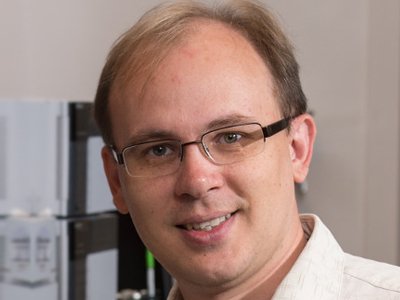Chemistry Professor Receives Five-Year NIH Award
Nearly $2 million grant will support investigation of catalytic activity in the body

Assistant professor of chemistry Ivan Korendovych was recently awarded a Maximizing Investigators’ Research Award (MIRA) from the National Institutes of Health (NIH). Korendovych, who is also an adjunct professor in the departments of biology at Syracuse University and radiology at SUNY Upstate Medical University, will use the $1.85 million award to study catalytic activity related to neurodegenerative diseases, drug resistance and new antimicrobial therapies.
”Ivan’s new NIH grant is exciting news. The work conducted in the Korendovych laboratory will pave ways to new approaches on treating neurodegenerative diseases. This award comes as the result of innovative and highly successful work in his laboratory,” says Karin Ruhlandt, dean of the College of Arts and Sciences and professor of chemistry.
This type of grant, which provides a uniquely long five-year funding period, enables scientists to focus on research instead of developing new grant proposals for shorter funding periods. According to the NIH, this funding model “provides investigators with greater stability and flexibility, thereby enhancing scientific productivity and the chances for important breakthroughs.”
Korendovych noted that this is the first MIRA to be awarded to an SU professor, as well as the first NIH research project grant for the chemistry department in almost two decades. “This award is also timely as we aim to strengthen our NIH presence on campus,” says Ruhlandt.
One project Korendovych’s lab will tackle is a brain phenomenon known as amyloid toxicity. Amyloids are proteins that fold in such a way that many copies of the same protein stick together, which can lead to toxicity in the brain—a hallmark of Alzheimer’s and other neurodegenerative diseases. Korendovych’s group discovered that far from being inactive, these amyloid plaques catalyze chemical reactions.
“Amyloid plaques are present in the brains of patients with neurodegenerative disease, but it is not quite clear why they are toxic,” Korendovych says. “We know there is redox stress on neurons, so our discovery of catalytic activity in amyloids, which may contribute to stress on neurons, can shed light on the exact mechanism of toxicity.”
Korendovych’s MIRA will also support the exploration of drug resistance, where pathogens spontaneously develop new catalytic activity, which prevents drugs from working as designed. “We know that resistance develops over time, but the exact ways it happens is much more difficult to elucidate,” he says. To that end, Korendovych plans to “evolve” small proteins by making small changes at the DNA level to identify what types of changes create and enhance catalytic activity against drugs.
Finally, MIRA funding will be used to develop antimicrobials to act against bacterial pathogens such as methicillin resistant Staph. aureus, a major health threat in hospital settings. One of the body’s defenses against invading microbes involves using catalysis to poke holes in the membranes surrounding bacteria and some viruses. Korendovych is developing a new fluorescent blue marker, azulene, to watch what happens during pore formation in real time. “It is much easier to develop new antimicrobial peptides with a real-time probe, like azulene. If you have a probe in your peptide candidates you can visually follow their biological activity, including pore formation,” he says.
The freedom of the five-year MIRA grant will bring clarity to these three specific questions, and even more fundamental issues, Korendovych says. “With this support, we can investigate how catalysis initially emerged and how new protein functionalities arise in the present.”
